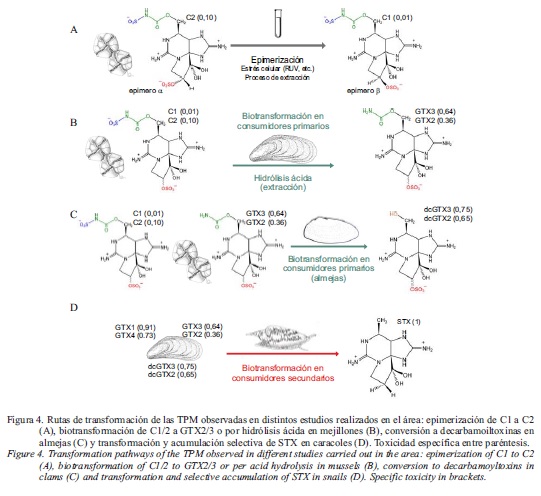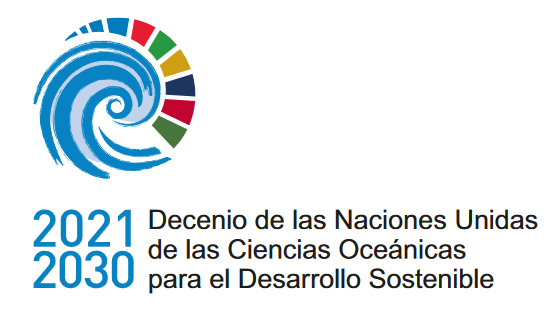Toxinas paralizantes de moluscos en el Mar Argentino: impacto, transferencia trófica y perspectiva
DOI:
https://doi.org/10.47193/mafis.3212019061805Palabras clave:
Floraciones de algas tóxicas, monitoreo de algas nocivas, dinoflagelados tóxicos, mortandad de organismos marinos, ArgentinaResumen
En el Mar Argentino, los dinoflagelados Gymodinium catenatum y el complejo Alexandrium tamarense/catenella producen potentes neurotoxinas (saxitoxinas) que pueden acumularse en moluscos y producir severas intoxicaciones en humanos conocidas como Intoxicación Paralizante por Moluscos. La transferencia de dichas toxinas a través de la cadena alimentaria puede tener consecuencias graves para la salud humana, la acuicultura, la pesca, la industria y la economía regional. Debido a las implicancias para la salud pública, se ha estudiado en profundidad el rol de los moluscos bivalvos en su transferencia. Sin embargo, es escasa la información que se posee sobre las toxinas bioacumuladas en el resto de los organismos marinos ya que no están sujetos a monitoreo. En un contexto de cambio climático global que puede favorecer la ocurrencia de eventos que involucren a las Toxinas Paralizantes de Moluscos (TPM), se presenta una síntesis de la información actualizada para el Mar Argentino sobre los dinoflagelados que las producen y su distribución, las toxinas involucradas y las transformaciones metabólicas que ocurren en su transferencia dentro de la red trófica. Se explora el impacto de las TPM en la integridad del ecosistema y las medidas de manejo y control que se utilizan para minimizar las consecuencias en la salud pública.
Descargas
Métricas
Citas
Akselman R, Carreto JI, Montoya NG. 1998. Gymnodinium catenatum and autumn toxicity in northern shelf waters of Argentina. En: Reguera B, Blanco J, Fernández ML, Wyatt T, editores. Harmful Microalgae. IOC-UNESCO. p. 122-123.
Almandoz GO, Montoya NG, Hernando MP, Benavides H, Carignan M, Ferrario ME. 2014. Toxic strains of the Alexandrium ostenfeldii complex in South America (Beagle Channel, Argentina). Harmful Algae 37: 100-109.
Álvarez M. [internet] c2012. Situación actual de las zonas de producción de moluscos bivalvos en referencia a los fenómenos de Marea Roja. Años 2008 al 2011. 5° Taller de Trabajo de la Red de Fortalecimiento para la Maricultura Costera Patagónica y del Taller de Cultivo de Mejillón. Available from: <http://www.cenpat-conicet.gov.ar/mariculturaenred/PresentacionesTaller/Mareasrojas-FerinoAlvarez.pdf>.
Andrinolo D, Santinelli N, Otaño S, Sastre V, Lagos N. 1999. Paralytic Shellfish Toxins in mussels and Alexandrium tamarense at Valdés Peninsula, Chubut, Patagonia, Argentina. Kinetics and natural depuration. J. Shellfish Res. 18: 203-209.
AOAC (Association of Official Analytical Chemists). 1985. Paralytic shellfish poison. Biological method. Final action. Official Methods of Analysis. Sec. 959.08. p. 21-22.
Avelino Rodriguez M.V. 2014. Evaluación de los resultados del laboratorio de toxinas marinas durante el periodo 2008-2012, en el marco del programa de vigilancia y control de marea roja en la provincia de Río Negro. Tesis de Licenciatura. Facultad de Ciencias Veterinarias, Universidad Nacional de La Pampa. 55 p.
Balech E. 1964. El plancton de Mar del Plata durante el período 1961-1962 (Buenos Aires, Argentina). Boletín Instituto Biología Marina (Mar del Plata) Nº 4: 1-59.
Benavides HR, Montoya NG, Carignan MO. 2016. Microalgas nocivas y eventos de toxicidad de moluscos bivalvos en el área del Canal Beagle, Provincia de Tierra del Fuego, Antártida e Islas del Atlántico Sur. Inf. Invest. INIDEP N°75. 65 p.
Benavides HR, Prado L, Díaz S, Carreto JI. 1995. An excepcional bloom of Alexandrium catenella in the Beagle Channel, Argentina. En: Lassus P, Arzul G, Erard-le-Den E, Gentien P, Marcaillou-Le Baut C, editores. Harmful Marine Algal Blooms. París: Lavoisier. p. 113-119.
Bertolotti MI, Pagani A, Gualdoni P, Fosati J. 2014. Cadena de producción del cultivo del mejillón en el año 2011 en la provincia de Tierra del Fuego, Antártida e Islas del Atlántico Sur, Argentina. Rev Galega Econo. 23: 33-50.
Bricelj VM, Shumway SE. 1998. Paralytic shellfish toxins in bivalve molluscs: occurrence transfer kinetics and biotransformation. Rev Fish Sci. 6: 315-383.
Cadaillón A. 2012. Floraciones Algales Nocivas: Ficotoxinas en fitoplancton y zooplancton de los Golfos Nuevo y San José. Tesis de Licenciatura. Universidad Nacional de la Patagonia San Juan Bosco. 154 p.
Carreto JI, Carignan MO, Montoya NG. 2007. [CD-ROM]. Florecimientos de algas nocivas. En: Boltovskoy D, editor. Atlas de Sensibilidad Ambiental de la costa y el Mar Argentino.
Carreto JI, Benavides HR, Negri RM, Glorioso PD. 1986. Toxic red-tide in the Argentine Sea. Phytoplankton distribution and survival of the toxic dinoflagellate Gonyaulax excavata in a frontal area. J Plankton Res. 8: 15-28.
Carreto JI, Lasta ML, Negri RM, Benavides HR. 1981. Los fenómenos de marea roja y toxicidad de moluscos bivalvos en el Mar Argentino. Contrib. Inst. Nac. Invest. Desarr. Pesq. (Mar del Plata) Nº399: 1-93.
Carreto JI, Elbusto C, Sancho H, Carignan MO, Yasumoto T, Oshima Y. 1996. Comparative studies on paralytic shellfish toxin profiles of marine snails, mussels and an Alexandrium tamarense isolate from the Mar del Plata coast (Argentina). Rev Invest Desarr Pesq. 10: 101-1070.
Carreto JI, Montoya NG, Akselman R, Negri R, Carignan MO, Cucchi Colleoni AD. 2004. Differences in the PSP toxin profiles of Mytilus edulis during spring and autumn blooms of Alexandrium tamarense off Mar del Plata coast. En: Steidinger KA, Landsberg JC, Tomas R, Vargo GA, editores. Harmful algae 2002: Proceedings of the X International Conference on Harmful Algae. Florida Marine Research Institute, Florida Fish and Wildlife Conservation Commission, Florida Institute of Oceanography, IOC-UNESCO, St. Pete Beach. p. 100-102.
Carreto JI, Montoya NG, Benavides HR, Carignan MO, Cucchi Colleoni AD, Akselman R. 1998. Alexandrium tamarense blooms and shellfish toxicity in the Argentine Sea: a retrospective view. En: Reguera B, Blanco J, Fernández ML, Wyatt T, editores. Harmful Microalgae. IOC-UNESCO. p. 131-134.
D’agostino VC, Degrati M, Sastre AV, Santinelli NH, Krock B, Krohn T, Dans SL, Hoffmeyer MS. 2017. Domoicacid in marine food web: Exposure of southern right whales Eubalaena australis in Península Valdés, Argentina. Harmful Algae 68: 248-257.
Doucette GJ, Mikulski CM, King KL, Roth PB, Wang Z, Leandro LF, Degrasse SL, White KD, De Biase D, Gillett RM, et al. 2012. Endangered North Atlantic right whales (Eubalaena glacialis) experience repeated, concurrent exposure to multiple environmental neurotoxins produced by marine algae. Environ Res. 112: 67-76.
Esteves JL, Santinell IN, Sastre V. 1992. A toxic dinoflagellate bloom and PSP production associated with upwelling in Golfo Nuevo, Patagonia, Argentina. Hydrobiologia 242: 115-122.
Etheridge SM. 2010. Paralytic shellfish poisoning: Sea food safety and human health perspectives. Toxicon 56: 108-122.
EU (European Union). 2004. Corrigendum to regulation (EC) N° 854/2004 of the European Parliament and of the Council of 29th April 2004 Laying down specific rules for the organization of official controls on products of animal origin intended for human consumption. O.J.E.U., L. 226. p. 83-127.
Fabro E, Almandoz GO, Ferrario ME, John U, Tillmann U, Toebe K, Krock B, Cembella AD. 2017. Alexandrium species from the Argentine Sea: diversity, distribution and associated toxins. J Phycology. DOI: https://doi.org/10.1111/jpy.12574
FAO (Organización de las Naciones Unidas para la Alimentación y la Agricultura). 2006. [internet] Joint FAO/WHO Food Standards Programme CODEX Committee on fish and fishery products. CX/FFP 06/28/6-Add.1. Disponible en: ftp://ftp.fao.org/es/esn/food/biotoxin_repor_en.pdf.
FAO (Organización de las Naciones Unidas para la Alimentación y la Agricultura). 2012. [internet] El estado mundial de la pesca y la acuicultura 2012. Departamento de Pesca y Acuicultura de la FAO, Roma. Disponible en: http://www.fao.org/docrep/016/i2727s/i2727s.pdf.
Farias NE, Obenat S, Goya A. 2014. Outbreak of a neurotoxic side-gilled sea slug (Pleurobranchaea sp.) in Argentinian coasts. N Z J Zool. 42: 51-56.
Fernández V, Kroekc M. 2013. Programa de Monitoreo de Calidad Ambiental de Zonas de Producción de Moluscos Bivalvos de la Provincia de Río Negro. Taller FAN, Chubut. Disponible en: http://www.agroindustria.gob.ar/sitio/areas/acuicultura/zonificacion.
Gayoso AM, Fulco K. 2006. Occurrence patterns of Alexandrium tamarense (Lebour) Balech populations in the Golfo Nuevo (Patagonia, Argentina) with observations on ventral pore occurrence in natural and cultured cells. Harmful Algae 5: 233-241.
Geraci JR, Anderson DM, Timperi Rj, Aubin Dj, Earj Y, Prescott JL, Mayo CA. 1989. Humpback whales (Megaptera novaeangliae) fatally poisoned by dinoflagellate toxin. Can J Fish Aquat Sci. 46: 1895-1898.
Gessner BD, Bell P, Doucette GJ, Moczydlowski E, Poli MA, Van Dolah F, Hall S. 1997. Hypertension and identification of toxin in human urine and serum following a cluster of mussel associated paralytic shellfish poisoning outbreaks. Toxicon 35(5): 711-722.
Gibbs R, Krista T, Wade R, Cory M, Mccarron P, Melanson J, Burton I, John W, Van De Riet J, Quilliam M. 2009. Detection and Identification of a Novel Saxitoxin Analogue in Scallops (Zygochlamys patagonica). Proceedings of Seventh International Conference on Molluscan Shellfish Safety, Nantes. p. 64-71.
Goya AB, Maldonado S. 2014. Evolution of PSP toxicity in shellfish from the Beagle Channel (Tierra del Fuego, Argentina): an overview. En: Sauvé G, editor. Molluscan shellfish safety. Springer, Netherlands. p. 15-23.
Goya A, Khun S, Najle S, Lasta M. 2009. Lack of Paralytic Shellfish Poison Toxin transfer from body to adductor muscle in patagonian scallops (Zygochlamys patagonica). Proceedings of Seventh International Conference on Molluscan Shellfish Safety, Nantes. DOI: https://doi.org/10.13140/RG.2.1.2218.0248
Hallegraeff GM. 1995. Harmful algal blooms: A global overview. En: Hallegraeff GM, Anderson DM, Cembella AD, editores. Manual on Harmful Marine Microalgae. IOC-UNESCO, Paris. p. 1-24.
Hallegraeff G. 2010. Ocean climate change, phytoplankton community responses, and harmful algal blooms: a formidable predictive challenge. J Phycol. 46: 220-235.
Kotaki Y, Oshima Y, Yasumoto T. 1985. Bacterial transformation of paralytic shellfish toxins in coral reef crabs and a marine snail. Nippon Suisan Gakkaishi 51: 1009-1013.
Krock B, Borel CM, Barrera F, Tillmann U, Fabro E, Almandoz GO, Ferrario ME, Garzón JE, Cardona BP, Koch C, et al. 2015. Analysis of the hydrographic conditions and cyst beds in the San Jorge Gulf, Argentina, that favor dinoflagellate population development including toxigenic species and their toxins. J Marine Syst. 148: 86-100.
Lawrence JF, Niedzwiadek B, Menard C. 2005. Quantitative determination of paralytic shellfish poisoning toxins in shellfish using prechromatographic oxidation and liquid chromatography with fluorescence detection: collaborative study. J. AOAC Int. 88. p. 1714-1732.
Lefebvre KA, Quakenbush E, Frame KB, Huntington G, Sheffield R, Stimmelmayr A, Bryan P, Kendrick H, Ziel T, Goldstein JA, et al. 2016. Prevalence of algal toxins in Alaskan marine mammals foraging in a changing arctic and subarctic environment. Harmful Algae 55: 13-24.
Marc Long KT, Soudant P, Le Grand F, Sarthou G, Jolley D, Hégaret H. 2016. Allelochemicals released by the toxic dinoflagellate Alexandrium minutum impact Chaetoceros neogracile photosystem and viability. Proceedings of the 17th International Conference on Harmful Algae (ICHA), Florianópolis, Brasil. DOI: https://doi.org/10.13140/RG.2.2.18317.95200
Méndez S, Ferrari G. 2003. Floraciones tóxicas de Gymnodinium catenatum en aguas uruguayas. Pub Com Tec Mix Fr Marít. 19: 97-102.
Méndez S, Kulis D, Anderson DM. 2001. PSP toxin production of Uruguayan isolates of Gymnodinium catenatum and Alexandrium tamarense. En: Hallegraeff G, Blackburn S, Lewis R, Bolch C, editores. Harmful Algal Blooms 2000. IOC-UNESCO. p. 352-355.
Montoya NG, Carignan M. 2011. Análisis de toxinas paralizantes de moluscos (TPM) de algunos organismos de la comunidad biológica asociada al frente de Península Valdés durante la campaña CC01/08. Inf. Invest. INIDEP N°34. 10 p.
Montoya NG, Carreto JI. 2007. Informe sobre mortandad de aves marinas ocurrida en las costas de Chubut (noviembre de 2006), asociada a la presencia de toxinas paralizantes de moluscos. Inf. Invest. INIDEP Nº34. 8 p.
Montoya NG, Carreto JI. 2009. Resultado del análisis de ficotoxinas en la Ballena Franca Austral (Eubalaena australis) durante un episodio de mortandad ocurrido en Península Valdés. Inf. Ases. Transf. INIDEP Nº16. 9 p.
Montoya NG, Carignan MO, Carreto JI. 2018. Alexandrium tamarense/catenella blooms in Southwestern Atlantic- Paralytic Shellfish Toxins production and its trophic transference. En: Hoffmeyer MS, Sabatini ME, Brandini FP, Calliari D, Santinelli NH, editores. Plankton Ecology of the Southwestern Atlantic, from Subtropical to the Subantarctic realm. Cham: Springer. p. 453-474.
Montoya NG, Akselman R, Carignan MO, Carreto JI. 2006. Pigment profile and toxin composition during a red tide of Gymnodinium catenatum (Graham) and Myrionecta rubra (Lohman) Jankowski in Mar del Plata coastal waters. African J Marine Sci. 28: 199-202.
Montoya NG, Akselman R, Franco J, Carreto JI. 1996. Paralytic shellfish toxins and mackerel (Scomber Japonicus) mortality in the Argentine Sea. En: Yasumoto T, Oshima Y, Fukuyo Y, editores. Harmful and Toxic Algal Blooms. IOC-UNESCO. p. 417-420.
Montoya NG, Fulco KV, Carignan MO, Carreto JI. 2010. Toxin variability in cultured and natural populations of Alexandrium tamarense from southern South America – Evidences of diversity and environmental regulation. Toxicon 56: 1408-1418.
Montoya NG, Reyero MI, Akselman R, Franco J, Carreto JI. 1998. Paralytic shellfish toxins in the anchovy Engraulis anchoita from Argentinian coasts. En: Reguera B, Blanco ML, Fernández J, Wyatt T, editores. Harmful Microalgae. IOC-UNESCO. p. 72-73.
Moroño A. 2013. [internet] Monitoreo de biotoxinas marinas: experiencias prácticas. Taller FAN, Chubut, Argentina. Disponible en: http://www.agroindustria.gob.ar/sitio/areas/acuicultura/zonificacion.
Negri A, Bolch CJ, Lindon E, Méndez SM. 2001. Paralytic shellfish toxins in Gymnodinium catenatum strains from six countries. En: Hallegraeff GM, Blackburn S, Bolch CJ, Lewis R, editores. Harmful Algal Blooms 2000. IOC-UNESCO. p. 210-214.
Negri AP, Bolch CJS, Geier S, Green DH, Park T-G, Blackburn SI. 2007. Widespread presence of hydrophobic paralytic shellfish toxins in Gymnodinium catenatum. Harmful Algae 6: 774-780.
Oshima Y. 1995. Chemical and enzymatic transformation of paralytic shellfish toxins in marine organisms. En: Lassus P, Arzul G, Erard E, Gentien P, Marcaillou C, editores. Harmful Marine Algal Blooms. Paris: Lavoisier. p. 475-480.
Persich GR, Kulis DM, Lilly EL, Anderson DM, Garcia VMT. 2006. Probable origin and toxin profile of Alexandrium tamarense (Lebour) Balech from southern Brazil. Harmful Algae 5: 36-44.
Prud’homme V R, Willem F. 2017. Report of the Nomenclature Committee for Algae: 15. Taxon 66(6). 191 p.
Reguera B. 2013. Floraciones de microalgas nocivas: diversidad de especies, diversidad de recursos afectados. [internet] Taller FAN, Chubut. Disponible en: http://www.agroindustria.gob.ar/sitio/areas/acuicultura/zonificacion.
Reis Costa P. 2014. Impact and effects of paralytic shellfish poisoning toxins derived from harmful algal blooms to marine fish. Fish Fish. DOI: https://doi.org/10.1111/faf.12105
Reyero M, Santinelli N, Otaño S, Sastre V, Maroño E, Franco J, Andrade A. 1998. Toxins profils of PSP from molluscs and phytoplankton containing Alexandrium tamarense (Lebour) Balech in two patagonian gulf (Argentina). En: Reguera B, Fernández ML, Wyatt T, editores. Harmful Algae. Xunta de Galicia. IOC-UNESCO. p. 507-508.
Ritchie JM, Rogart RB. 1977. The binding of saxitoxin and tetrodotoxin to excitable tissue. Rev. Physiol. Biochem. Pharmacol. 79: 42-50.
Santinelli N. 2013. Monitoreo de FAN en la costa de la Provincia de Chubut. [intranet] Taller FAN, Chubut, Argentina. Disponible en: http://www.agroindustria.gob.ar/sitio/areas/acuicultura/zonificacion.
Santinelli N, Sastre V, Estévez JL. 2002. Episodios de algas nocivas en la Patagonia Argentina. En: Sar EA, Ferrario ME, Reguera B, editores. Floraciones Algales Nocivas en el Cono Sur Americano. Inst. Esp. Oceanogr. Vigo. p. 197-208.
Sastre V. 2013. Clasificación de Zonas y Monitoreo de Floraciones Algales Nocivas (FANs) y Ficotoxinas. [internet] Taller FAN, Chubut, Argentina. Disponible en: http://www.agroindustria.gob.ar/sitio/areas/acuicultura/zonificacion.
Sastre AV, Santinelli NH, Willers V, Solis ME, Díaz Ovejero S, Pérez LB, Pérez AA, Fajardo MA, Gracia Villalobos L, Marino GR. 2013. Floraciones de Alexandrium tamarense y TPM en el Golfo San Jorge. Proceedings of the XXXIV Jornadas Argentinas de Botánica, La Plata, Argentina. Bol. Soc. Argent. Bot. 48 (Supl.). p. 175.
Shimizu Y, Yoshioka M. 1981 Transformation of paralytic shellfish toxins as demonstrated in scallop homogenates. Science 212: 547-549.
Shimizu Y. 2000. Chemistry and mechanism of action. En: Botana LM, editor. Seafood and Freshwater Toxins: Pharmacology, Physiology, and Detection. Marcel Dekker, Nueva York. p. 151-172.
Shumway SE, Allen SM, Dee Boersm P. 2003. Marine birds and harmful algal blooms: sporadic victims or under-reported events? Harmful Algae 2: 1-17.
Smith EA, Grant F, Ferguson CMJ, Gallacher S. 2001. Biotransformations of paralytic shellfish toxins by bacteria isolated from bivalve molluscs. Appl. Environ. Microbiol. 67: 2345-2353.
Sugawara A, Imamura T, Aso S, Ebitani K. 1997. Change of paralytic shellfish poison by the marine bacteria living in the intestine of the Japanese surf clam, Pseudocardium sybillae, and the brown sole, Pleuronectes herensteini. Sci Rep Hokkaido Fish Exp Stn. 50: 35-42.
Sullivan JJ, Iwaoka WT, Liston J. 1983. Enzymatic transformation of PSP toxins in the littleneck clam (Protothaca staminea). Biochem Biophys Res Commun. 114: 465-472.
Sunesen I, Lavigne A, Goya A, Sar EA. 2014. Episodios de toxicidad en moluscos de aguas marinas costeras de la Provincia de Buenos Aires (Argentina) asociados a algas toxígenas (marzo de 2008-marzo de 2013). Bol Soc Argent Bot. 49: 327-339.
Turner AD, Tarnovius S, Goya A. 2014. Paralytic Shellfish Toxins in the Marine Gastropods Zidona dufresnei and Adelomelon beckii from Argentina: Toxicity and Toxin Profiles. J Shellfish Res. 33: 519-530.
Uhart M, Montoya NG, Lisnizer N, García Borboroglu P, Gatto A, Svagelj W, Mauco L, Carreto JI. 2008. Mortalidad de gaviota cocinera (Larus dominicanus) por toxina paralizante de los moluscos en Chubut, Argentina. Proceedings of the XII Reunión Argentina de Ornitología, San Martín de los Andes, Argentina, Resúmenes. p. 60.
Uhart M, Karesh W, Cook R, Huin N, Lawrence KB, Guzman L, Pacheco H, Pizarro G, Mattsson R, Mörner T. 2004. Paralytic shellfish poisoning in gentoo penguins (Pygoscelis papua) from the Malvinas Islands. Proceedings of the AAZV/AAWV/WDA Joint Conference, San Diego. p. 481-486.
Van de Riet JM, Gibbs RS, Chou FW, Muggah PM, Rourke WA, Burns G, Thomas K, Quilliam MA. 2009. Liquid chromatographic post-column oxidation method for analysis of paralytic shellfish toxins in mussels, clams, scallops, and oysters: single-laboratory validation. J AOAC Int. 92: 1690-1704.
Wiese M, D’agostino PM, Mihali TK, Moffitt MC, Neilan BA. 2010. Neurotoxic Alkaloids: Saxitoxin and Its Analogs. Mar Drugs 8: 2185-2211.
Wilson C, Sastre AV, Hoffmeyer M, Rowntree VJ, Fire SE, Santinelli NH, Díaz Ovejero S, D’agostino V, Marón CF, Doucette GJ, et al. 2016. Southern right whale (Eubalaena australis) calf mortality at Península Valdés, Argentina: are harmful algal blooms to blame? Mar Mammal Sci. 32: 423-451.

Publicado
Cómo citar
Número
Sección
Licencia
Derechos de autor 2020 Nora Montoya

Esta obra está bajo una licencia internacional Creative Commons Atribución-NoComercial-CompartirIgual 4.0.
Los autores de los artículos publicados en Marine and Fishery Sciences conservan los derechos de autor de sus artículos, a excepción de las imágenes de terceros y otros materiales añadidos por Marine and Fishery Sciences, que están sujetos a los derechos de autor de sus respectivos propietarios. Por lo tanto, los autores son libres de difundir y volver a publicar sus artículos, sujeto a los requisitos de los propietarios de derechos de autor de terceros y sujeto a que la publicación original sea completamente citada. Los visitantes también pueden descargar y reenviar artículos sujetos a los requisitos de citas. La capacidad de copiar, descargar, reenviar o distribuir cualquier material siempre está sujeta a los avisos de derechos de autor que se muestran. Los avisos de copyright deben mostrarse de manera prominente y no pueden borrarse, eliminarse u ocultarse, total o parcialmente. El autoalmacenamiento en servidores y repositorios de preimpresión está permitido para todas las versiones.
Esta revista ofrece a los autores una política de acceso abierto. Los usuarios pueden leer, descargar, copiar, distribuir, imprimir, buscar o vincular los textos completos de los artículos, o usarlos para cualquier otro propósito legal dentro de la licencia Creative Commons 4.0 (BY-NC-SA), sin solicitar permiso previo del editor o del autor. Esto está de acuerdo con la definición BOAI de acceso abierto.



























